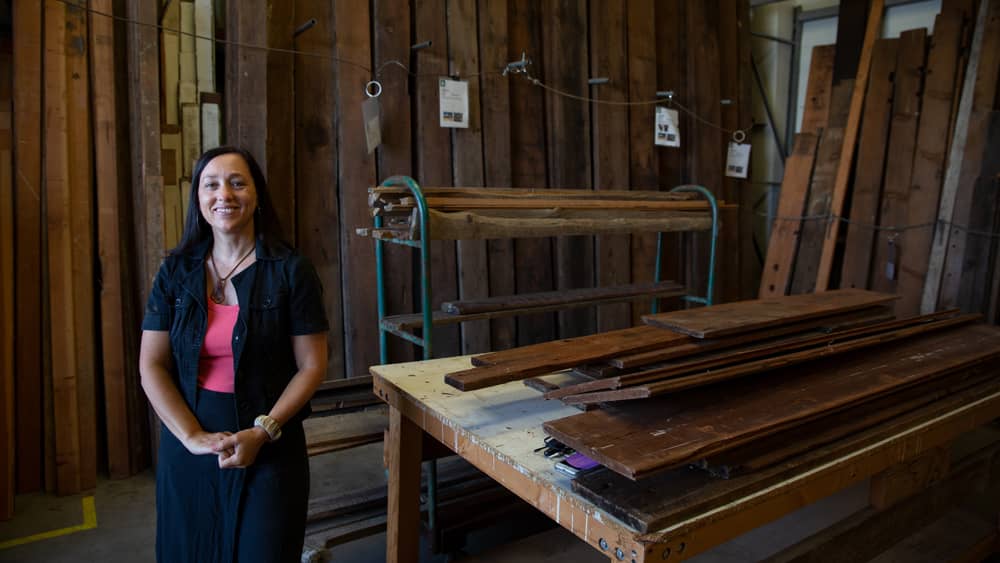
Ashlee Murphy and the Good Bones Design Build Team. [Photo courtesy of Good Bones Design Build]
About two years ago, Sonoma County-based apprentice carpenter Katie Estupiñan applied for a job with a local construction company and was told they were not hiring, after being told by someone she knew to apply there because they needed people. Then, a short time later, she ran into employees who work at the company, and asked about job opportunities. “They told me, ‘Oh, we’re hiring like crazy.’
“Companies can’t say they won’t hire you because you’re a woman, of course,” she adds. But the message came through loud and clear to Estupiñan. “And from what I’ve been told, some [companies] don’t want women because they think we can’t do the work. Others sometimes don’t want to mix genders and deal with all the issues that could come up with that. Some companies will hire women just to meet a diversity quota, but the majority seem to have no issue with it at all and welcome anyone who is hard working and willing to learn the trade.”
Estupiñan, 37, joined the Northern California Carpenters Regional Council almost two-and-a-half years ago, but began working in construction three years before that as a nonunion carpenter, after having been employed in “traditional female jobs such as office work,” she says. When she was laid off from an office job with a neighboring county, she needed to find another position that paid well enough to keep the day-care provider she didn’t want to lose, while also coordinating hours around her husband’s work schedule.
In 2020, approximately 291,000 women in the United States worked as electricians, carpenters, masons, plumbers, painters, sheet metal and iron workers and in other jobs in the construction trades.—U.S. Bureau of Labor
After applying to the carpenters union and being accepted, Estupiñan graduated from the six-week pre-apprentice program. She is now halfway through her eight-step apprenticeship, which requires working a certain number of hours as well as passing two classes in a six-month period to move up through each step. As an apprentice carpenter, she receives a raise as she ascends each of the eight steps, as long as she meets the work and education criteria.
“My dad, who raised me, was a single father and is a nonunion carpenter. When I was a kid and I didn’t have to go to school, I’d go to jobsites with him,” she says. “I’ve always been around construction. Dad always taught me to be self-sufficient, and I’ve always been a bit of a tomboy.”
Rewarding, but not easy
In 2020, approximately 291,000 women in the United States worked as electricians, carpenters, masons, plumbers, painters, sheet metal and iron workers and in other jobs in the construction trades, based on figures from the U.S. Bureau of Labor. A breakdown of BOL statistics from 2018 (the most recent year available) reveal that women workers are substantially underrepresented in construction, at just 10%. The percentages were more than double for women in other fields such as agriculture (26%), manufacturing (29%) and transportation (24%). So why don’t more women pursue careers in the construction trades?
“We still have a long way to go, but more women in the construction trades bring different values and priorities to our work.”—Nicole Tai, president, GreenLynx
“For every five construction workers retiring, only one is coming into the industry,” explains Robin Bartholow, director of workforce development for North Coast Builders Exchange and director of the North Bay Construction Corps. One estimate shows that more than 200,000 construction and skilled trades workers are leaving the workplace every year. “We call it the ‘silver tsunami’,” she quips, a phrase that describes numerous industries losing workers to retirement. “Adding more women in the trades would take a huge bite out of that worker shortage problem for the construction industry. But historically, this industry hasn’t been as welcoming to young women. It is much different now, and women in this industry are thriving.”
Making it known that having women in the construction trades is to society’s benefit, says Nicole Tai, might require an effective and wide-reaching public service advertising campaign. Tai is a third-generation general contractor and president of Sonoma County-based GreenLynx. Tai says the company provides “full and surgical” building deconstruction, building materials sales, reuse logistics and green consulting. GreenLynx essentially builds in reverse, she explains, taking materials out of buildings being torn down and keeping them out of landfills and as pristine as possible so they can be reused.

But, she adds, the male-dominated construction industry is not an easy business for women to be in. “The reason I left the building side of construction to go into the reuse side is to try to help change the industry from the inside-out,” adds Tai, 48.
Having more women as decision-makers and tradespeople in construction will be a good thing, she adds. “Women have a certain way of looking at the building world. Men are on a different wavelength when it comes to how we should build and why. We need to make a profit, yes, and do things in a particular way, but women oftentimes ask the tough questions. We still have a long way to go, but more women in the construction trades bring different values and priorities to our work. The fact that we are already in the industry is helping start to change it.”
Little encouragement
Science and math skills came naturally to Ashley Murphree, 35, who went straight into engineering in college. With a bachelor’s degree in mechanical engineering and environmental engineering, she got a job with an architecture and engineering company in her native Michigan, where she learned HVAC and plumbing design, and how to design LEED-certified green buildings. Together with her business partner Spencer Dobrovolny, the two are co-owners of Marin County-based Good Bones Design Build, constructing residential projects and using what is known as “passive house” design principles as their mantra, Murphree says. According to the International Passive House Association, passive houses require drastically lower energy to achieve a comfortable year-round temperature, turning the home itself into a thermal battery and making conventional heating and air conditioning systems obsolete. This includes using airtight construction techniques and installing high-quality insulation and heat recovery ventilation.
“I got into passive house building as a path to creating sustainable buildings, and it just spoke to me.” The implications of using simple airtight construction to greatly diminish the need for complex solar and battery systems in a net-zero energy future are enormous. She holds certified designer and certified tradesperson credentials for the International Passive House Association building standard. Good Bones is a small company, she says, and the crew is a tight-knit group. “We hire through word-of-mouth and workforce development programs. We are blessed with our current crew members who have turned out to be amazing people and craftspersons.”

Working alongside new male subcontractors can be a little tricky at times, she says. “I don’t know if it’s just my design background, [but] I often ask for non-traditional installations and they frequently are not willing to change the way they do things. Standing my ground with the gender dynamic at work can be really hard in these situations. Plumbers, for instance—I have a plumbing design background and I know how some things are supposed to work. I can show the subcontractor how I want him to install it and why. Being stubborn, sometimes they don’t want to do it, so we just don’t hire them again.”
Carpenter Estupiñan is usually the only female on a jobsite, or one of the few, as she is assigned to union projects, which last anywhere from a few weeks to a few months, or even longer depending on the project. Last year, she was on the same jobsite for the entire year. “Sometimes there are guys on the crews that call women ‘sweetie’ or ‘darlin,’ but they don’t mean anything by it. It’s just the way the older generation and guys from smaller towns talk, and it’s usually their way of being nice to women on site. In general, all the men are respectful and behave pretty well around me. I’ve even made some new friends in the trades in the short time that I’ve been in the union. But [as a female] when you go anywhere new, whether it’s a jobsite or anywhere else for that matter, you’re always cautious, no matter what.”
Now that more women are realizing they can master this type of work and are entering the fields of construction, she adds, the environment is changing. “Women in construction I’ve read about on social media sites, who’ve worked a long time in the trades, were routinely bullied and talked down to over the years. Those women have paved the way for my generation, the women entering the industry now and the generations to come. There is more acceptance that women can do the work.”
Tough skin, no jerks
Tai and Murphree belong to the Building Women group within the Marin Builders Association, formed three years ago as a resource for women in construction who are members of the association. The group meets monthly (virtually over the past year) to share advice on running their businesses, networking and marketing techniques, and new building codes that will affect their work.
Tai initially asked to start the women’s group within the association. “I was missing female colleague energy that I had experienced in other jobs, and thought that if I meet with other women contractors they will see there is a high need for it. And that’s exactly what I found.” The group has approximately 30 members.
“Camaraderie among women is important,” she adds. “Being able to process things with someone who walks in the same shoes is crucial because what we sometimes have to endure on a jobsite can be atrocious and shouldn’t be a part of our society, but it is. Hostility toward women on jobsites is not an isolated thing. If we want to change it, we have to know who it’s happening to and work together to make it better.
“I have such a tough skin now from working in construction, but nobody should ever have to get ‘used’ to it. It helps to talk with other women, find out what’s going on in another company and how that company is handling it. Because I’m able to be part of the hiring process for my company, the men we hire aren’t jerks. The men we hire are awesome and have no issue with working for a woman.”
Rick Wells, CEO of the Marin Builders Association, says the Building Women group was launched as a response to having many outstanding women leaders in construction in Marin, and gives them the opportunity to connect to learn and support one another. “The group has been a tremendous resource for our association since day one,” he says. “We have multiple board members that have come from the group, and these dynamic leaders cumulatively represent hundreds of years of experience in construction, managing businesses and working in our community.”
Bartholow of the NCBE says her organization is currently looking into offering a professional women’s group for its members. “We hope to start a Women in Construction committee to feature successful women in the industry who want to tell their stories and mentor other women getting started.”
A good kind of exhaustion
American society places too much emphasis on pushing young people into four-year colleges, ignoring skilled trades as a career option, says Tai. “And as a result, we are in some dire straits,” she adds. “There are no formal avenues for doing apprenticeships except through unions, and those jobs are almost exclusively on commercial projects, not residential work. Roofing and HVAC work, for instance, is all done by nonunion labor.”
Estupiñan echoes her colleague’s thoughts on higher education. “College is great, but not everyone is interested in going to college. This work keeps me physically active, and I like that each project is always different. Even if I’m doing similar tasks, I still have to figure things out and challenge myself. I like the problem-solving and the different scenery and constantly learning something new. Working in an office is the same thing every day and that gets tiring. Even though this is physical work, it’s a good kind of exhaustion.”
Training Center to Break Ground
Early in 2020, a $7.12 million federal grant was awarded to build a training center in Sonoma County “dedicated to cultivating a new crop of construction professionals,” according to a prepared joint statement issued by Santa Rosa Junior College and the Sonoma County Economic Development board. The 10,000-square foot structure, called the North Bay Regional Construction and Building Trades Employment Training Center, is being built on SRJC’s Petaluma campus.
At press time, the schematic design phase for the project was underway, and a groundbreaking was expected this spring. Construction should be completed by June 2023 and the center open for classes that fall. The center will offer short-term training certificates in many trade specialties.
The grant came from U.S. Economic Development Administration disaster relief funds to help rebuild the construction labor pool in the North Bay impacted in part by the wildfires in 2017. SRJC contributed $780,000 in land for the center.
“The center, operating at full capacity, should produce up to 500 skilled jobseekers each year, which will make a big impact on the critical shortage of trained workers in the construction industry,” said Nancy Miller in the prepared statement. She is director of Regional Adult Education Programs for SRJC and the Sonoma County Adult Education Consortium, who led SRJC’s efforts to secure the grant funding.
“We look forward to this facility being a complement to the existing construction training programs in Marin County, and the curriculum of the College of Marin,” says Rick Wells, CEO of Marin Builders Association. “There’s no end in sight for the need for workers in the construction field. It’s a great way to make a living, and the demand for these skilled trades is not going away.”
Outreach to Female High School Seniors
The North Bay Construction Corps program was launched in 2017 to provide high school seniors with career exploration and basic skills training in construction to prepare them for opportunities to work in entry-level positions. The program was founded through a partnership with the North Coast Builders Exchange, CTE Foundation, Sonoma County Office of Education and Santa Rosa Junior College. The goal is to provide the information students need to decide whether they want to choose construction as a career, and to instill the soft skills employers are looking for in employees.
Robin Bartholow, director of workforce development for the North Coast Builders Exchange and director of the North Bay Construction Corps, oversees the program. Students come from various high schools in the five North Bay counties. There are four chapters in Sonoma County (Healdsburg, Rohnert Park, Sonoma Valley, West County), one in Napa County (American Canyon), one in Lake County (Kelseyville), one in Mendocino County (Ukiah) and one in Marin County (Terra Linda).
One goal of the program is to increase the number of young women participating. “So far, not as many young women have signed up for the annual 14-week program as we would like, but we’re working on it,” says Bartholow. The program starts in January and ends in May, followed by a two-week paid internship or Boot Camp experience in June where students work on a real construction project. This year the program had only three young women among 62 students, but efforts are underway to attract more women. “We’ve increased our outreach directed at these students because it’s our belief that part of the workforce crisis the construction industry is experiencing would be greatly improved if we had as many women interested in the industry as men,” says Bartholow.
Times have changed, and working conditions for women in a male-dominated industry are much improved, she adds, but it’s a career path that’s still underrepresented by females. “It’s an industry that many women just haven’t looked at, so we are trying to feature it more now among these young female students, who might be wondering what their next step is after high school.”
One of the best things about the NBCC program, she says, is that even though some of the high school seniors who complete the classes and the hands-on work may still go on to a four-year college, the majority want to go into a skilled trade. “They want to shine here, and many of them do.”
Bartholow says students who complete the program and are placed in an entry-level position are generally paid $18 to $25 per hour initially. After three to five years, these same students could be earning up to $50 an hour as a journeyman in their chosen trade.
Author
-

Jean Doppenberg is a lifelong journalist and the author of three guidebooks to Wine Country.
View all posts



